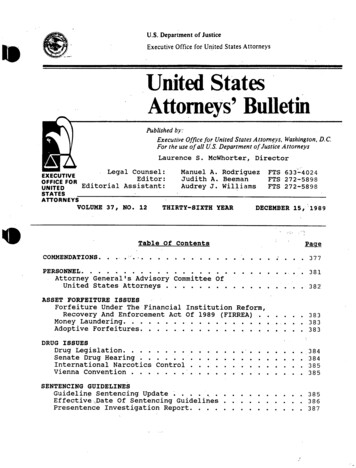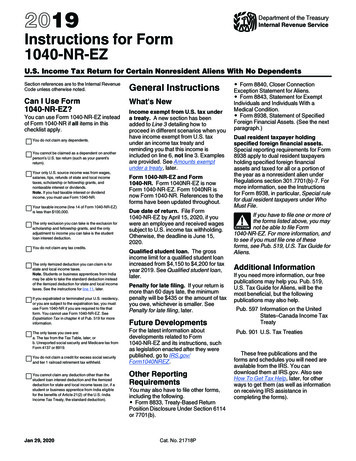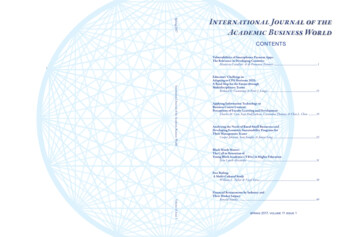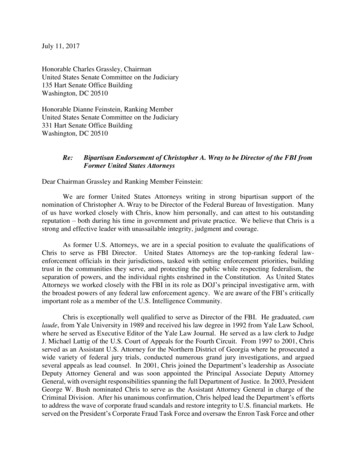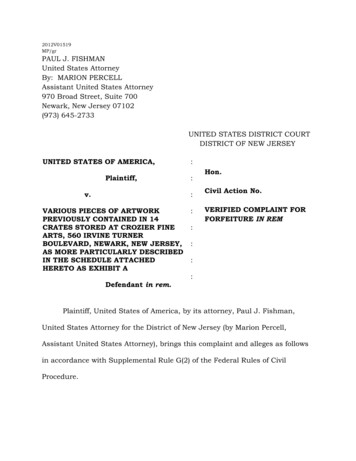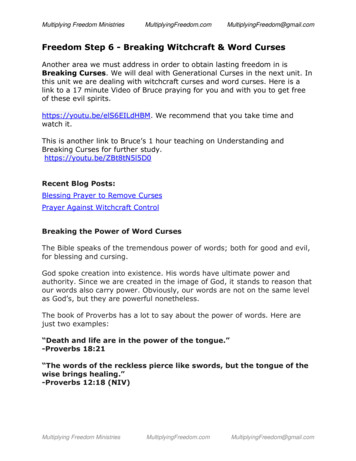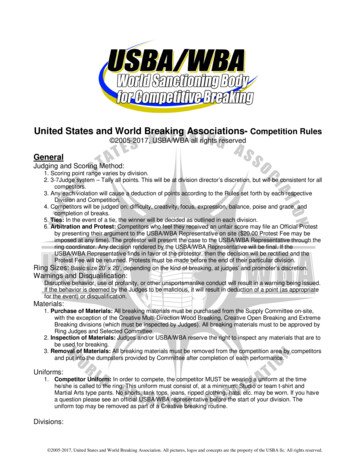
Transcription
United States and World Breaking Associations- Competition Rules 2005-2017, USBA/WBA all rights reservedGeneralJudging and Scoring Method:1. Scoring point range varies by division.2. 3-7Judge system – Tally all points. This will be at division director’s discretion, but will be consistent for allcompetitors.3. Any/each violation will cause a deduction of points according to the Rules set forth by each respectiveDivision and Competition.4. Competitors will be judged on: difficulty, creativity, focus, expression, balance, poise and grace, andcompletion of breaks.5. Ties: In the event of a tie, the winner will be decided as outlined in each division.6. Arbitration and Protest: Competitors who feel they received an unfair score may file an Official Protestby presenting their argument to the USBA/WBA Representative on site ( 20.00 Protest Fee may beimposed at any time). The protestor will present the case to the USBA/WBA Representative through thering coordinator. Any decision rendered by the USBA/WBA Representative will be final. If theUSBA/WBA Representative finds in favor of the protestor, then the decision will be rectified and theProtest Fee will be returned. Protests must be made before the end of their particular division.Ring Sizes: Basic size 20’ x 20’, depending on the kind of breaking, at judges’ and promoter’s discretion.Warnings and Disqualification:Disruptive behavior, use of profanity, or other unsportsmanlike conduct will result in a warning being issued.If the behavior is deemed by the Judges to be malicious, it will result in deduction of a point (as appropriatefor the event) or disqualification.Materials:1. Purchase of Materials: All breaking materials must be purchased from the Supply Committee on-site,with the exception of the Creative Multi-Direction Wood Breaking, Creative Open Breaking and ExtremeBreaking divisions (which must be inspected by Judges). All breaking materials must to be approved byRing Judges and Selected Committee.2. Inspection of Materials: Judges and/or USBA/WBA reserve the right to inspect any materials that are tobe used for breaking.3. Removal of Materials: All breaking materials must be removed from the competition area by competitorsand put into the dumpsters provided by Committee after completion of each performance.Uniforms:1. Competitor Uniform: In order to compete, the competitor MUST be wearing a uniform at the timehe/she is called to the ring. This uniform must consist of, at a minimum: Studio or team t-shirt andMartial Arts type pants. No shorts, tank tops, jeans, ripped clothing, hats, etc. may be worn. If you havea question please see an official USBA/WBA representative before the start of your division. Theuniform top may be removed as part of a Creative breaking routine.Divisions: 2005-2017, United States and World Breaking Association. All pictures, logos and concepts are the property of the USBA llc. All rights reserved.
1. Weight Divisions: Where specified, weight divisions will be as follows: Men- Light Weight – 199.9 andunder, Heavy Weight - 200 and over; Women- Light Weight- 160.9 and under, Heavy Weight - 161 andover. Weigh-in will take place at the registration area as registration is done or at the rings. Thecompetitor’s weight will be written on his/her competition ticket.2. Divisions with Fewer than 5 Competitors may be combined with the next closest division at thediscretion of the Judges.3. Rank Breakdown:Beginner: 1-12 months of training; white, yellow, orange; 10th, 9th, 8th belt level.thththIntermediate: 12-24 months; lt. blue, green, purple; 7 , 6 , 5 belt level.thrdndstAdvanced: 24-48 months; brown, red, navy, stripe belts; 4 , 3 , 2 , 1 belt level.Black Belt: All Black Belts regardless of training period or rank.4. Entries: Competitors may enter as many divisions as they wish (it is the competitor’s responsibility toenter all competitions when called).5. Divisions with Cash Prizes: Cash prizes will be awarded at the promoter’s discretion. At most eventsyou must be a USBA/WBA member to be eligible for cash awards.Time Limits:1. IMPORTANT: In order to keep the breaking divisions running smoothly, competitors will be required toadhere to the time limits outlined. This is very important, and deductions will be enforced. It would be tothe competitor’s benefit to practice set-ups, breaks, and clean-ups before the day of the event.2. Competitor Readiness: A competitor must be ready to compete, as determined by the judges, as soonas that competitor’s name is called in the ring.Safety: The safety of the competitor and the audience comes first, NO EXCEPTIONS! The safety of thecompetitor is very important and we request that the instructor of the competitor approve all breaks. If the breakis deemed to be unsafe by the Judges or the USBA/WBA Representative on site, we reserve the right to restrictthe break. No material may leave the ring as a result of breaking unless planned for beforehand, to ensure thatno other competitor, spectator, or Judge will be struck or put in danger by material as a result of a break. If thisoccurs, the Judges have the right to disqualify the competitor if they feel that the safety of others wascompromised. Also, the break cannot cause damage to the facility or surrounding fixtures.First Time Breakers Division1. This division is specifically for individuals who have never competed at a USBA/WBAsanctioned breaking competition before. Competitors entered in this division may not compete in anyother division. The purpose of this division is to introduce new competitors to USBA/WBA breaking.2. Materials: Wood boards only. 3 boards included in division registration. Competitor may purchaseadditional boards per materials ordering.3. Stands: Stands will be provided.4. Techniques: All techniques are allowed. Competitor may use any strike to break.5. Competitor Grouping: Competitors will be grouped at the discretion of the ring coordinator. Groupingcan be by age, rank, gender, or size depending on the number of competitors registered.6. Stations: 3 Stations Max.- The competitor may set up 3 stations. Each break will be considered onestation. A station may be free standing, set on stands, or held by assistants. Competitor will beresponsible for all materials required to set up their stations. Competitors will also be required to ensurethe safety of fellow competitors and spectators as outlined in “General: Safety” above.7. Time Limits: Competitors will be expected to set-up, break, and clean-up in a timely fashion. Amaximum of 3 minutes to set-up, break, and clean up the area may or may not be used depending on anumber of factors. All competitors will be held to the same standard, whether timed or not. Time iscumulative, determined as follows: time starts when competitor starts set-up, time stops whencompetitor completes set-up, time starts again upon the attempt of the first break, time stops when thering is cleared as determined by the ring coordinator.8. Judging: Competitor will be judged on difficulty, creativity, focus, and completion of breaks.9. Ties: In the event of a tie, the winner will be decided by the exclusion of low and/or high scores or ashow of hands—at the Judges’ discretion.Creative Multi-Direction Wood Breaking1. Materials: Wood boards only. Competitor may purchase boards on-site or provide their own. 2005-2017, United States and World Breaking Association. All pictures, logos and concepts are the property of the USBA llc. All rights reserved.
2. Props: Props and “prop stations” may be used. Competitor will be allowed a maximum of 3 propstations that will not be included in their routine for scoring purposes. Competitor must communicateprop stations to the ring coordinator and judges before the start of their routine.3. Techniques: All techniques are allowed. Competitor may use any strike to break.4. Breaking Stations: Tiny Tott & Beginner and Intermediate Competitors- 4 Stations Max.,Advanced and Black Belt Competitors- 8 Station Max. The competitor may set up the maximumnumber of breaking stations for his/her specific rank. Each break will be considered one station.Simultaneous breaks will be considered one station. If competitor leaves the ground all breaks executedbefore he/she returns to the ground will be considered one station. A station may be free standing, seton stands, or held by assistants. Competitor will be responsible for all materials required to set up theirstations. Competitors will also be required to ensure the safety of fellow competitors and spectators asoutlined in “General: Safety” above.5. Time Limits: Competitor will have a maximum of 3 minutes to set-up, break, and clean up the area. Adeduction of 3 points will be taken off the competitor’s final score for every 15 seconds over the allottedtime. Deductions will begin after the 3-minute mark. Time is cumulative, determined as follows: timestarts when competitor starts set-up, time stops when competitor completes set-up, time starts againupon the attempt of the first break, time stops when the ring is cleared as determined by the ringcoordinator.6. Judging: Competitor will be judged on difficulty, creativity, focus, and completion of breaks.7. Ties: In the event of a tie, the winner will be decided by the exclusion of low and/or high scores, a 1station break-off, or a show of hands—at the Judges’ discretion.Creative Multi-Directional Team Breaking1.2.3.4.5.6.7.8.Team Members: teams must consist of 2 competitors. Neither age nor rank needs to be in the samecategoryMaterials: Wood boards only. Competitor may purchase boards on-site or provide their own.Props: Props and “prop stations” may be used. Competitor will be allowed a maximum of 3 propstations that will not be included in their routine for scoring purposes. Competitor must communicateprop stations to the ring coordinator and judges before the start of their routine.Techniques: All techniques are allowed. Competitor may use any strike to break.Breaking Stations: 8 Station Max. Regardless of rank. The competitors may set up the maximumnumber of breaking stations. Each break will be considered one station. Simultaneous breaks will beconsidered one station. If competitor leaves the ground all breaks executed before he/she returns to theground will be considered one station. Both competitors must break, but there is no requirement as tohow many breaks each competitor must perform, only that the combined total of breaks stations is 8 orless. A station may be free standing, set on stands, or held by assistants. Competitor will be responsiblefor all materials required to set up their stations. Competitors will also be required to ensure the safety offellow competitors and spectators as outlined in “General: Safety” above.Time Limits: Competitor will have a maximum of 3 minutes to set-up, break, and clean up the area. Adeduction of 3 points will be taken off the competitor’s final score for every 15 seconds over the allottedtime. Deductions will begin after the 3-minute mark. Time is cumulative, determined as follows: timestarts when competitor starts set-up, time stops when competitor completes set-up, time starts againupon the attempt of the first break, time stops when the ring is cleared as determined by the ringcoordinator.Judging: Competitor will be judged on difficulty, creativity, focus, and completion of breaks.Ties: In the event of a tie, the winner will be decided by the exclusion of low and/or high scores, a 1station break-off, or a show of hands—at the Judges’ discretion.Points: there will be NO points awards towards the annual ratings for this event.Creative Open Breaking - Any Materials, No Fire or Glass Breaks1. Materials: Any materials can be used except fire and glass breaks. Examples of materials are cementblocks, wood boards, concrete, wood poles, bricks, metal, etc. Creativity of materials used, props, andtechniques will increase a competitor’s score. Music is allowed, but competitor will be responsible formusic.2. Props: Props and “prop stations” may be used. Competitor will be allowed a maximum of 3 propstations that will not be included in their routine for scoring purposes. Competitor must communicate 2005-2017, United States and World Breaking Association. All pictures, logos and concepts are the property of the USBA llc. All rights reserved.
3.4.5.6.7.prop stations to the ring coordinator and judges before the start of their routine. Glass may be used as aprop, such as a bed of glass, as long as it is contained and not broken on site.Techniques: All techniques are allowed. Competitor may use any strike to break.Breaking Stations: The competitor may set up a maximum of 10 stations. Each break will beconsidered one station. Simultaneous breaks will be considered one station. If competitor leaves theground all breaks executed before he/she returns to the ground will be considered one station. Astation may be free standing, set on stands, or held by assistants. Competitor will be responsible for allmaterials required to set up their stations. Competitors will also be required to ensure the safety offellow competitors and spectators as outlined in “General: Safety” above.Time Limits: Competitor will have a maximum of 6 minutes to set-up, break, and clean up the area. Adeduction of 3 points will be taken off the competitor’s final score for every 15 seconds over the allottedtime. Deductions will begin after the 6-minute mark. Time is cumulative, determined as follows: timestarts when competitor starts set-up, time stops when competitor completes set-up, time starts againupon the attempt of the first break, time stops upon the completion of the last break, time starts whenclean-up begins, time stops when the ring is cleared as determined by the ring coordinator.Judging: Competitor will be judged on difficulty, creativity, focus, and completion of breaks.Ties: In the event of a tie, the winner will be decided by the exclusion of low and/or high scores, a 1station break-off, or a show of hands—at the Judges’ discretion.Extreme Kicks & Tricks Wood BreakingMaterials: Wood boards only. Competitor will be provided with up to 6 Boards (1/2”x10”x12”).2. Props: Props may be used. (ie. Apparatus to hold boards, or obstacles to create difficulty)3. General Concept: This division was created to showcase techniques and acrobatic talent as displayedin “Extreme Forms” and “Tricking”, with the added requirement of breaking a board. Competitors shouldkeep this in mind when preparing for this event.4. Techniques: All techniques should be variations of Spinning, Jumping, Flying or Flipping Kicks. Techniquesthat combine multiple aspects of these variations will be awarded a higher point value All boards must be broken with the foot. Traditional depictions of Kicks as well as acrobatic moves which allow the foot momentum tobreak a board.5. Stations: Each competitor may attempt up to 3 breaks or series of breaks (stations), not to exceed theoverall 6 board maximum. An order of competition will be established and followed throughoutthe competition. For example, if there are 3 competitors competitor A will set up and executetheir first break, followed by competitor B, followed by competitor C. This process will continueuntil a competitor has exhausted all of his/her 6 boards or until the completion of 3 stations percompetitor, whichever comes first. All Strikes must be single boards (no “stacks”). Simultaneous strikes (striking board at one moment in time) will be considered onebreak/station. Airborne is defined as the period of time when the competitor’s first foot leaves the floor or prop,until the moment the last foot returns to the floor or prop. A station may be free standing, set on stands, or held by assistants. Competitor will be responsible for all materials required to set up their stations. Competitors will also be required to ensure the safety of fellow competitors and spectators asoutlined in “General: Safety” above.6. Time Limits: The competitor will have 1 Minute to set-up, break, and clean up the area for EACHSTATION. Timing is continuous and specific to each station- time starts when competitor begins set-upand time stops when the ring is cleared as determined by the ring coordinator. The time will then resetfor the next competitor. A deduction of .5 point will be assessed for every 15 seconds over the 1 minutetime limit per station, starting at 1 minute 1 second. This is different than with the other events so pleasetake notice.1. 2005-2017, United States and World Breaking Association. All pictures, logos and concepts are the property of the USBA llc. All rights reserved.
Competition Process: Once the competition order is established and the competition begins the firstcompetitor will setup their first station, immediately execute the break and clear the area, all while timeis running. Time will be reset and the second competitor will be called up, setup their first station,immediately execute the break and clear the area. Once all competitors have completed their firststation, the first competitor will set up his/her second station in the same manner. This will be followedby the second competitor and so on. This process will continue until all competitors have exhaustedtheir 6 board allotment or each competitor has completed 3 stations, whichever comes first.a. Each competitor will have a maximum of 2 attempts per station. If the board/boards are notndbroken after the 2 attempt the station will be considered unsuccessful and no points will beearned for that station.8. Judging: Competitor will be judged on technical difficulty, creativity, and completion of breaks asoutlined on the Extreme Kicks Chart for technical values.a. If a competitor fails to break ALL boards attempted during a station, then that break will beconsidered unsuccessful and no points will be awarded for that station.b. A competitor is allowed 2 attempts per station as outlined above. A break will be deemedsuccessful and awarded points provided all boards attempted are broken within the 2 attempts.c. Each station will earn the competitor 1-10 points from the Extreme Kicks Chart. The competitorwith the highest total point value at the end of the competition will win.d. If a competitor executes a break that is not listed on the Extreme Kicks Chart a point value willbe awarded at the judge’s discretion based on consideration of the other breaks listed on theExtreme Kicks Chart and the similarity of the break in question. If a competitor executes a breaknot listed and is determined to be below the skill level of the minimum breaks listed, that breakwill be considered unsuccessful and no points will be awarded.9. Ties: In the event of a tie, the winner will be decided by the exclusion of low and/or high scores, a 1station break-off, or a show of hands—at the Judges’ discretion.7.Power Concrete BreakingHand1. Materials and Spacers: Blocks must be purchased on site from Supply Committee. Carpenter pencilspacers will be provided.2. Techniques: Hand technique only (Palm, punch, chop, etc.). Technique must be a downward strike.3. Weight divisions: See “General: Divisions” above.4. Stations: One station will be used. Blocks will be set on a block base. Competitors may set up as manyblocks as they wish. Competitors will be required to ensure the safety of fellow competitors andspectators as outlined in “General: Safety” above.5. One Strike Only! Competitor has one attempt to break the blocks.6. Time Limits: Competitor will have a maximum of 6 minutes to set up. Time starts when the competitorsignals he/she is ready, time stops when the competitor signals to the ring coordinator that his/her setup is complete. Additional time will be counted if a set-up is to be significantly altered as determined bythe ring coordinator. A deduction of ½ block will be taken off the competitor’s total break for every 15seconds over the allotted time. Deductions will begin after the 6-minute mark.7. Judging: Judges will count the number of blocks broken to determine the winner. The competitor whobreaks the most (or, in the event of a tie, has the highest percentage broken) is the winner.8. Ties: In the event of a tie, the winner will be decided by the highest percentage broken. Example:Competitor “A” breaks 10 out of 10; competitor “B” breaks 10 out of 12. Competitor “A” broke at 100%;competitor “B” broke at 83%. Competitor “A” is the winner. If more than one competitor has the samepercentage broken after their initial break, there will be a break off to determine the winner. If there is atie created by more than one competitor breaking 100% of their stack (example: 2 competitors break 10out of 10), the competitor that broke the amount first is the winnerElbow1. Materials and Spacers: Blocks must be purchased on site from Supply Committee. Carpenter pencilspacers will be provided.2. Techniques: Elbow technique only (drop elbow, overhand elbow, etc.). Technique must be adownward strike.3. Weight divisions: See “General: Divisions” above. 2005-2017, United States and World Breaking Association. All pictures, logos and concepts are the property of the USBA llc. All rights reserved.
4. Stations: One station will be used. Blocks will be set on a block base. Competitors may set up as manyblocks as they wish. Competitors will be required to ensure the safety of fellow competitors andspectators as outlined in “General: Safety” above.5. One Strike Only! Competitor has one attempt to break the blocks.6. Time Limits: Competitor will have a maximum of 6 minutes to set up. Time starts when the competitorsignals he/she is ready, time stops when the competitor signals to the ring coordinator that his/her setup is complete. Additional time will be counted if a set-up is to be significantly altered as determined bythe ring coordinator. A deduction of ½ block will be taken off the competitor’s total break for every 15seconds over the allotted time. Deductions will begin after the 6-minute mark.7. Judging: Judges will count the number of blocks broken to determine the winner. The competitor whobreaks the most (or, in the event of a tie, has the highest percentage broken) is the winner.8. Ties: In the event of a tie, the winner will be decided by the highest percentage broken. Example:Competitor “A” breaks 10 out of 10; competitor “B” breaks 10 out of 12. Competitor “A” broke at 100%;competitor “B” broke at 83%. Competitor “A” is the winner. If more than one competitor has the samepercentage broken after their initial break, there will be a break off to determine the winner. If there is atie created by more than one competitor breaking 100% of their stack (example: 2 competitors break 10out of 10), the competitor that broke the amount first is the winner.Foot1. Materials and Spacers: Blocks must be purchased on site from Supply Committee. Carpenter pencilspacers will be provided.2. Techniques: Foot technique only (Stomp, Axe kick, etc.). Technique must be a downward strike.3. Weight divisions: See “General: Divisions” above.4. Stations: One station will be used. Blocks will be set on a block base. Competitors may set up as manyblocks as they wish. Competitors will be required to ensure the safety of fellow competitors andspectators as outlined in “General: Safety” above.5. One Strike Only! Competitor has one attempt to break the blocks.6. Time Limits: Competitor will have a maximum of 6 minutes to set up. Time starts when the competitorsignals he/she is ready, time stops when the competitor signals to the ring coordinator that his/her setup is complete. Additional time will be counted if a set-up is to be significantly altered as determined bythe ring coordinator. A deduction of ½ block will be taken off the competitor’s total break for every 15seconds over the allotted time. Deductions will begin after the 6-minute mark.7. Judging: Judges will count the number of blocks broken to determine the winner. The competitor whobreaks the most (or, in the event of a tie, has the highest percentage broken) is the winner.8. Ties: In the event of a tie, the winner will be decided by the highest percentage broken. Example:Competitor “A” breaks 10 out of 10; competitor “B” breaks 10 out of 12. Competitor “A” broke at 100%;competitor “B” broke at 83%. Competitor “A” is the winner. If more than one competitor has the samepercentage broken after their initial break, there will be a break off to determine the winner. If there is atie created by more than one competitor breaking 100% of their stack (example: 2 competitors break 10out of 10), the competitor that broke the amount first is the winner.Speed Board Breaking – Competitor and 2 assistants, 3-person team1. Materials: Boards must be purchased on site from Supply Committee. No spacers are allowed.2. 3-Person Team: Each competitor will be allowed 2 assistants for a total of 3 people. The competitormay utilize the assistants to hold or replenish stands, but only the competitor will be allowed to break.3. Techniques: All techniques are allowed. Competitor may use any hand or foot strike to break.4. Stations: 5-station maximum, each station may have more than one board. A station can be a holder orstands set up on the ground. If stands are set on ground, they can be no longer then one standardstand deep (standard stands are 8 X 8 X 16”. The depth can be no more than 16” from the sidewhere the competitor will be standing to the back of the station). The competitor may utilize eachstation as many times as needed, as long as he/she stays within the time limits. The assistants can beused to replenish stations. Competitors will be required to ensure the safety of fellow competitors andspectators as outlined in “General: Safety” above.5. All boards must be broken on their station. If a board falls off of a station or out of a holders handsthe board must be set back up on the station or back in the holders hands before being broken. If theboard is broken in any other position it will not count toward the final count. 2005-2017, United States and World Breaking Association. All pictures, logos and concepts are the property of the USBA llc. All rights reserved.
6. Pre-Break Count and Inspection: The competitor must provide the number of boards that he/she isattempting to break, within the breaking time limit, to the judges before they start their break. All materialmust be in the competitor’s ring available for inspection before the start of the break. The number ofboards attempted compared to the number broken will be used to determine the winner in the event of atie (see “Ties” below).7. Time Limits: Competitor will have a maximum of 3 minutes to set up. A deduction of 1 board will betaken off the competitor’s total break for every 15 seconds over the allotted time. Deductions will beginafter the 3-minute mark.8. Breaking Time Limit: The competitor will have 10 seconds to break as many boards as possible. Timestarts when the competitor begins his first break. The 10-second breaking time is part of the overall 3minute time limit.9. Judging: Judges will count boards broken to determine the winner.10. Ties: In the event of a tie, the winner will be decided by the highest percentage broken. Example:Competitor “A” breaks 15 out of 15; competitor “B” breaks 15 out of 17. Competitor “A” broke at 100%;competitor “B” broke at 88%. Competitor “A” is the winner. If more than one competitor has the samepercentage broken after their initial break, there will be a break off to determine the winner. If there is atie created by more than one competitor breaking 100% of their boards (example: 2 competitors break20 out of 20), the competitor that broke the amount first is the winner.Creative Speed Board Breaking – Competitor and 2 assistants, 3-person team1. Materials: Boards must be purchased on site from Supply Committee. No spacers are allowed.2. 3-Person Team: Each competitor will be allowed 2 assistants for a total of 3 people. The competitormay utilize the assistants to hold or replenish stands, but only the competitor will be allowed to break.3. Techniques: All techniques are allowed. Competitor may use any hand or foot strike to break.4. Stations: 5-station maximum, each station may have more than one board. A station can be a holder orother apparatus. Any apparatus or set-up may be used in the Creative Speed Board BreakingDivision, as long as the 5-station maximum is adhered to. The competitor may utilize each stationas many times as needed, as long as he/she stays within the time limits. The assistants can be used toreplenish stations. Competitors will be required to ensure the safety of fellow competitors and spectatorsas outlined in “General: Safety” above.5. All boards must be broken on their station. If a board falls off of a station or out of a holders handsthe board must be set back up on the station or back in the holders hands before being broken. If theboard is broken in any other position it will not count toward the final count.6. Pre-Break Count and Inspection: The competitor must provide the number of boards that he/she isattempting to break, within the breaking time limit, to the judges before they start their break. All materialmust be in the competitor’s ring available for inspection before the start of the break. The number ofboards attempted compared to the number broken will be used to determine the winner in the event of atie (see “Ties” below).7. Time Limits: Competitor will have a maximum of 3 minutes to set up. A deduction of 1 board will betaken off the competitor’s total break for every 15 seconds over the allotted time. Deductions will beginafter the 3-minute mark.8. Breaking Time Limit: The competitor will have 10 seconds to break as many boards as possible. Timestarts when the competitor begins his first break. The 10-second breaking time is part of the overall 3minute time limit.9. Judging: Judges will count boards broken to determine the winner.10. Ties: In the event of a tie,
USBA/WBA Representative finds in favor of the protestor, then the decision will be rectified and the Protest Fee will be returned. Protests must be made before the end of their particular division. Ring Sizes: Basic size 20' x 20', depending on the kind of breaking, at judges' and promoter's discretion.




